Mining in Huelva Province, Andalucia from the Copper Age to the 21st century including British mining companies in the 19th century
By Nick Nutter | Updated 20 Mar 2022 | Andalucia | History |
Login to add to YOUR Favourites or Read Later
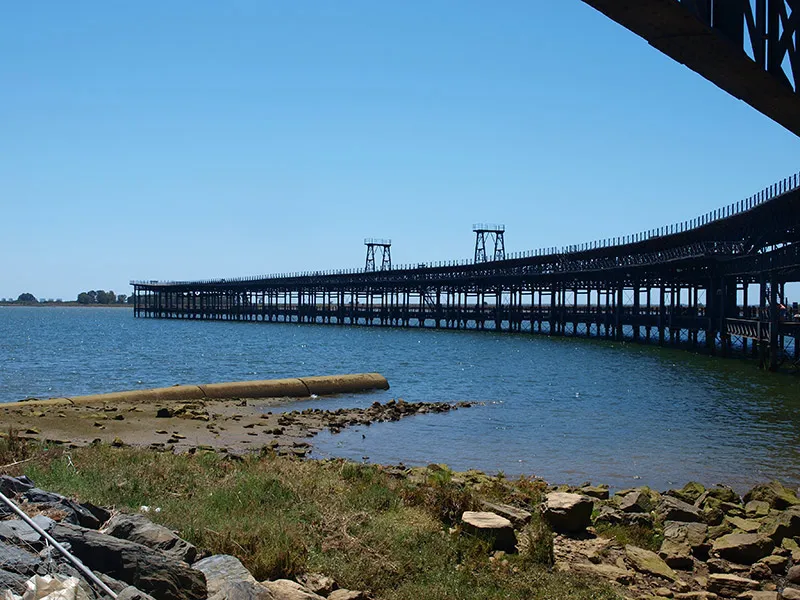
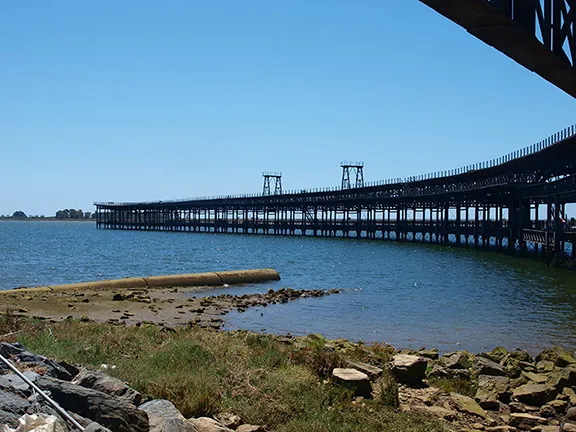
Muelle del Rio Tinto Huelva
The southern Iberian pyrite belt is the largest repository of massive sulfide deposits in the world. The deposits are all of volcanic origin, water at very high temperatures and pressures, pushing up through the earth’s crust dissolving metallic and non-metallic minerals and eventually condensing out in vertical fissures in the rock folds and spreading outwards, forcing its way horizontally between bands of rock and through cracks at a time when the bedrock was on the floor of an ocean. Later folding pushed the Iberian pyrite belt above the water. Huelva province has some of the largest deposits, classified non scientifically as super-giant deposits.
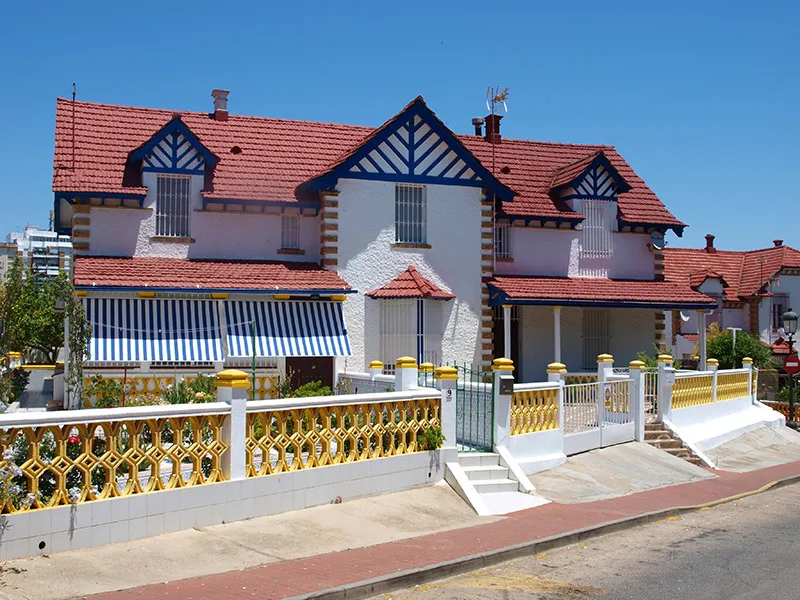
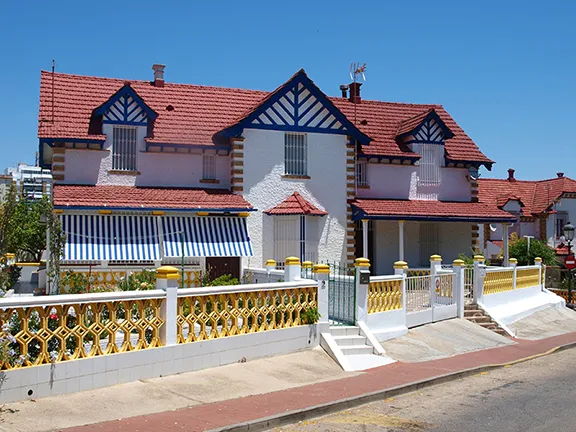
Barrio de Reina Victoria
The sulphides contain many metallic elements, the largest deposit in Huelva is at Rio Tinto, that also happens to be one of the oldest mining areas in the province with evidence dating back to 2750 BC, the early Copper Age. At Rio Tinto, miners through the ages have found zinc, copper, lead, arsenic, cadmium, sulphur, silver, thallium, mercury, gold and barium. Mining activity has occurred pretty well consistently from the copper age, then by Tartessians working with Phoenicians, followed by the Romans who used slaves, the Muslims used native labour and slaves and, during the modern age, until the 19th century, native workers worked for local landowners and a few Spanish mining companies.
Studies carried out in the 21st century, looking at pollution levels in the sediments of the Rio Tinto and Cádiz Bay have proved that the mining activities have been producing toxic waste for 5,000 years.
Today the headwaters of the Rio Tinto, where they emerge from beneath the mine tailings, run vermillion red and canary yellow in a toxic mix that prohibits all life barring some incredibly adapted microbes. The 19th century saw a revolution in mining activity and a consequent increase in pollution.
Pollution can also occur spontaneously with potentially horrific results. On April 25, 1998 one of the waste lagoon dams of the Los Frailes lead-zinc mine belonging to the Swedish - Canadian enterprise Boliden in Aznalcóllar broke. Five million cubic metres of toxic sludge and acid waters flowed over 60 kilometres down the Guadiamar River, the salt marshes and Entremuros, eliminating aquatic life and depositing heavy metals throughout the area. The avalanche of water and sludge was stopped just before arriving at the Doñana National Park thanks to the rapid construction of an emergency dam.
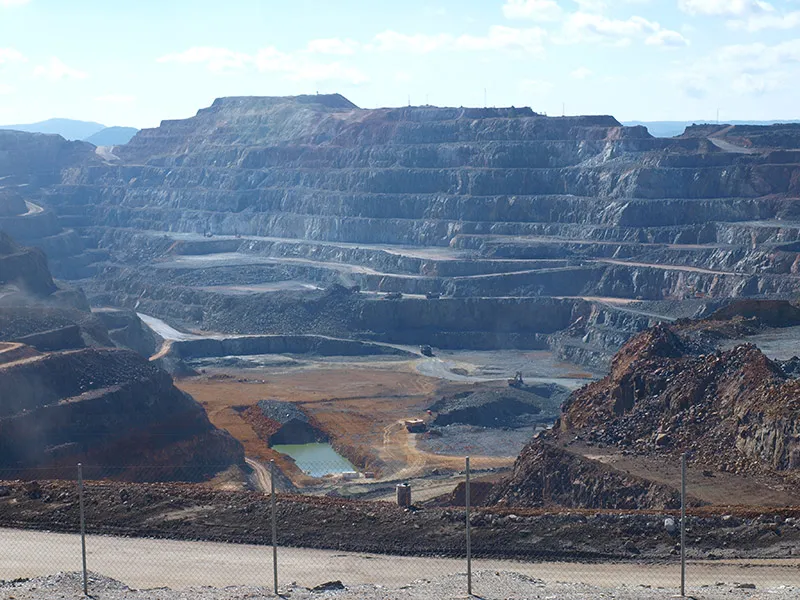
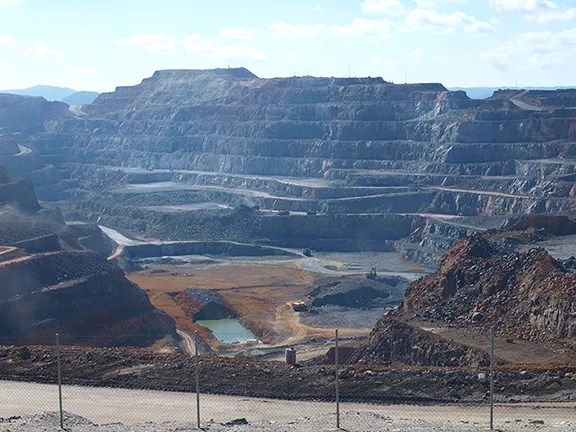
Colorado Open Cast Mine Rio Tinto
Previous restrictions on foreign companies owning mining concessions in Spain were relaxed by the Spanish Mining Law in 1848/49. This was followed in 1849 by a reduction in Spanish tariffs for the importation of mining machinery, including steam engines. Britain, with its almost insatiable demand for iron, copper and other metals to fuel the industrial revolution and build a Royal Navy, saw the money making potential and, out of all the European nations, had most involvement in Spain, particularly Andalucia.
In Huelva province, between 1841 and 1920, there were 53 registered British Mining Companies. The emphasis was on the massive copper pyrite deposits, copper and iron sulphide, sometimes called chalcopyrite. The British companies with most longevity and documented histories, were the Tharsis Sulphur and Copper Company formed in 1866 and the Rio Tinto Company formed in 1873.
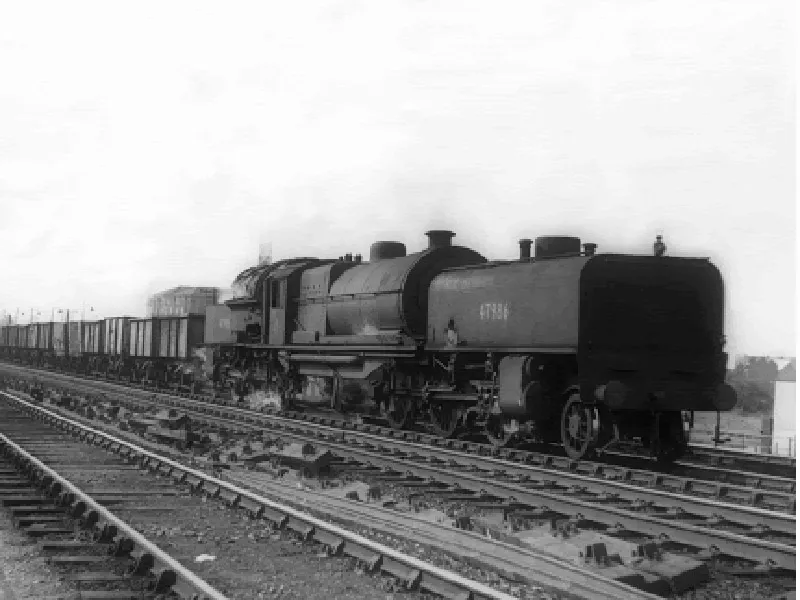
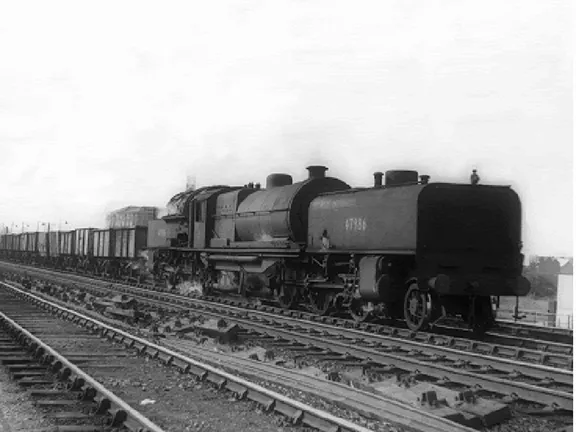
Garrett Locomotive
With its connotations of Tartessians, biblical mentions and Greek myths, the Tharsis mine in Huelva has a magnetic attraction. The name Tharsis is the Greco-Latin word for the biblical Tarshish, the land at the western extremity of the known world. And here the connection stops. The Tharsis mine is in the municipality of Alosno, about 40 kilometres northeast of Huelva. The mine is 10 kilometres north of the town of Alonso.
Although there is evidence of mining activity back in the Copper Age, it seems that the name Tharsis was only used as a name for the mine in modern times since the 19th century when in the 1850s a French company tried and failed to exploit the mines there that had not seen a miner since Roman times.
They were taken over by the Tharsis Sulphur and Copper Company Limited in 1866. Incorporated in Edinburgh in the same year, and with its head office in Glasgow, a Scot, Charles Tennant (later Sir Charles), was the company's principle founder and first chairman.
Charles Tennant represented all the visionary entrepreneurship of a Victorian Britain at the zenith of its imperial, industrial and economic power. The principles and practice of an Imperialism imposed in colonies such as India, were exported to Tharsis.
The packhorses, mules and carts used by the French to transport the ore to Corrales on the east bank of the Odiel river opposite Huelva, were replaced by about 50 kilometres of railway. Corrales benefitted from a new pier with docking facilities and a telegraph line back to Tharsis. The locomotives that hauled the ore carriers were all British, as was much of the mining machinery. Even the design of the railway stations were British. In more recent times the 'Terex' haulers, gigantic ore carrying lorries used in the mine, originated in the UK. The combination greatly reduced the loading times of the steam powered ore carriers. When the principle mining effort was transferred to La Zarza in 1888, a further 30 kilometres of line was laid.
The practice until 1866 was to mine the ore via a system of adits, tunnels and galleries. In order to support those tunnels and galleries, pillars of ore bearing rock were left undisturbed. This process is known as pillar and stall mining. The Tharsis Sulphur and Copper Company Limited introduced open cast mining to Tharsis. Open cast mining obviously takes all the available ore, it also requires less mining skill and reduces labour costs. Tharsis produced sulphur and copper and smaller amounts of gold, silver and iron.
Three communities were created, one at each of the mines and a smaller settlement at the railway terminal and pier at Corrales. They housed about 8,000 people, fifty of which were the British managers who imposed strict discipline and a culture totally divorced from that of the traditional and largely illiterate, Spanish, workforce. A colonial type of segregation bred an increasingly volatile working environment.
In the 1890s, the copper ores started to show signs of exhaustion and the company switched to sulphur extraction only. Production was interrupted during the First World War which was followed by a world depression. Mine workers became more militant and called several strikes.
In 1934 the Spanish Civil War introduced a period of nationalistic fervour and political instability. That war had hardly ended before the Second World War disrupted production yet again. Soon after that war, new sources of sulphur were found in areas of the world where labour was cheap. The price of sulphur fluctuated widely.
The final straw for the Tharsis Sulphur and Copper Company Limited came in the 1960s when Spain became very conscious of foreign exploitation of their resources. The company was sold to Campañia Española de Minas de Tharsis SAL, a Spanish company, and later passed to Nueva Tharsis SAL, a labour company created in 1996. It soon ceased production.
That may not be the end of the story for Tharsis and La Zarza. In the 1990s a survey was carried out by an Irish company to evaluate unexplored copper, gold and silver reserves. Test drillings were made in 2004 to establish the viability of resuming mining operations. Today (2020) the Tharsis Mining and Metalurgy is a Spanish company that owns Tharsis, La Zarza and San Telmo mines and it seems determined to reopen them.
The legacy of Tharsis Sulphur and Copper Company Limited is still there to be seen in the disintegrating mine machinery. The Corrales pier is in danger of collapse. Of the terminal with its railway tracks, yards, workshops, garage, stores, crushing plants and civil guards' barracks, only a crumbling building with its chimneystack and the railway station survive. It is not all bad news.
The 1920s station at Corrales has been carefully restored, as has the 'Teatro Cinema Corrales', originally opened in 1954 by H P Rutherford II, (the then Tharsis managing director and chairman) and the Casino Minero de Corrales, built in 1918 as a cultural and recreation centre. All are a reminder of the company's British connection.
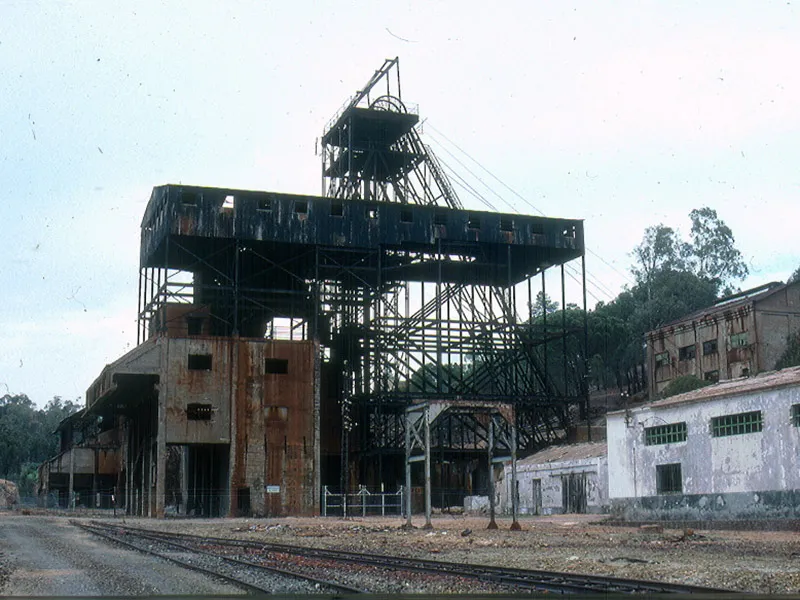
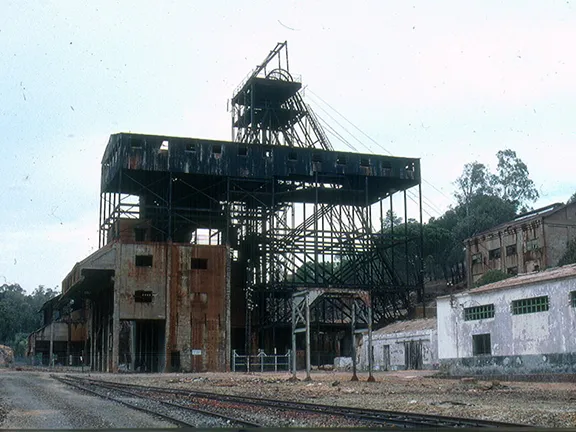
Headgear at La Zarza
Unlike Tharsis, there is evidence of mining at Rio Tinto almost continuously from the Copper Age through to the modern age. By the time the Romans departed, shafts had already been driven down to the water table and below. The museum at Huelva has an incredible display of a human powered Roman water wheel that was found in the Rio Tinto mine.
The Rio Tinto Mining Company Ltd. started operations at the mines in Rio Tinto in 1873. As with Tharsis mine, the Spanish company that preceded them had used the pillar and stall method to mine the copper pyrites. This left up to 80% of the ore underground. Nevertheless, in its early years the Rio Tinto Mining Company continued this method and imported Cornish pumping engines so that the workings could be deepened. Eventually the number of cave ins persuaded the management to go for open cast mining.
The founder and first chairman of the company was a London banker, Hugh Matheson. He was a devout Presbyterian from the western highlands of Scotland. During his chairmanship welfare facilities were considerably improved at Rio Tinto and schools built at his own as well as company expense, primarily to improve literacy and enable bible reading.
Under his leadership, the company became the greatest mining centre in the world. At the time of his death in 1898, Hugh Matheson was one of most powerful men in the economic life of Spain. The Rio Tinto Company was the biggest and most heavily capitalised commercial organisation in the country. It was the largest single employer of labour and provider of social services, paid substantial taxes and spearheaded the transformation of Huelva from village into industrial city.
The first chairman, Hugh Matheson, was succeeded by a general manager in 1908, Walter Browning who became known as ‘El Rey de Huelva’ for the absolute and autocratic power he wielded from his ‘court’, ‘Casa Grande’, a house in Bella Vista.
The pyrites at Rio Tinto occurs in two zones, referred to as the north and south lodes. There were three open pits exploiting the north lode, Dehasa, Lago and Salomon and two on the south lode, Filon Sur and Atalaya. The pit for which the mine is famous today, Colorado, was dug much later and the spoil from Colorado was used to fill Filon Sur. Atalaya, excavated in 1907 and exploited under Browning is one of the world’s largest open cast mines and is a stunning sight. Dazzling with colour, it dwarves the buildings that hug its rim. Rail tracks, part of a 300-kilometre system blasted and cut through difficult terrain, once spiralled to the bottom where, just discernible, is a rusting locomotive.
Part of the process of refining the ore involves burning it in the open air. This releases noxious sulphur fumes, a health hazard to anybody in the vicinity. Eventually the Spanish government issued an edict banning the process but only after the mine had experienced unrest and strikes. In 1888 troops had to be called to quell a riot. They fired into a group of miners and villagers killing or wounding 48 people.
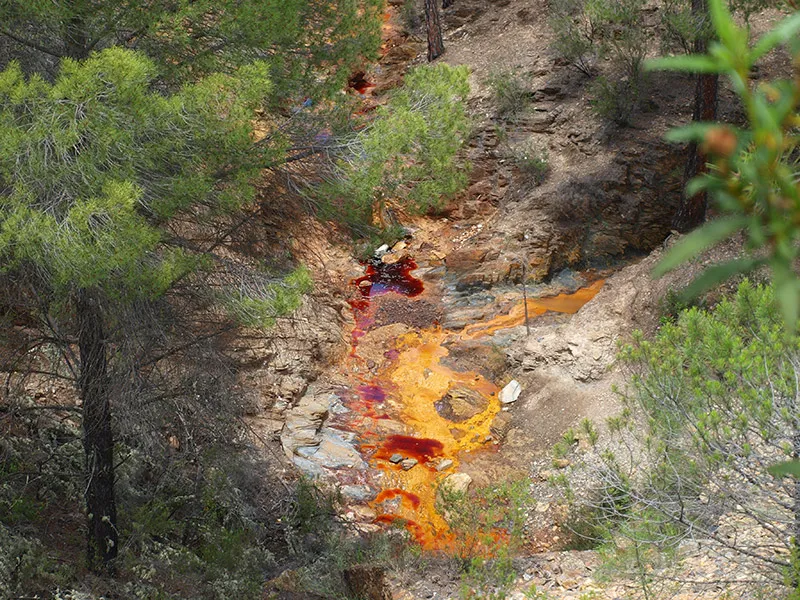
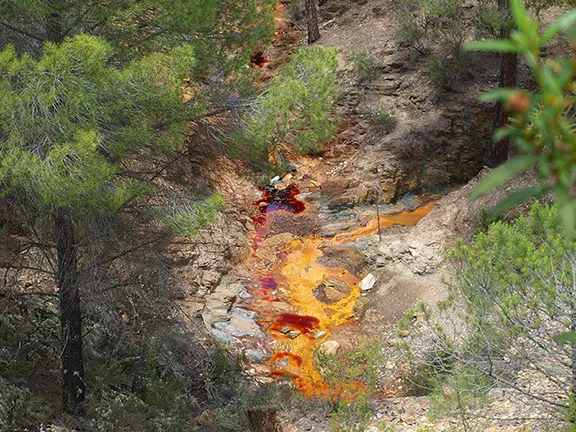
Rio Tinto Headwaters
The company built an eighty kilometre long railway line to carry the ore to Huelva and a loading dock called the Muelle del Tinto, that projects out into the Rio Tinto. Now carefully preserved it is a major tourist attraction for the city. The Estacíon de Sevilla, the neo-Moorish style RENFE station in Huelva, was built by the company in 1880.
At the mine end of the main line, a network of lines fanned out through tunnels into the open pits making the extraction of ore very efficient for the day. The original trains could tow 250 tons of ore. In 1929 the company bought two Garrett locomotives that could each tow 1,500 tons. Annual output of ore swung between 1.5 million tons per year to a peak in the 1920s of 2.5 million tons.
To house the British management an estate was built just west of the mine called Bella Vista. The estate included a Presbyterian church, a social club and a cemetery, the tombstones of which have English inscriptions. It housed about 120 management personnel strictly segregated from the Spanish. Life for the British centred on Club Inglés in Bella Vista where a photograph of ‘El Rey de Huelva’, Walter Browning, still hangs along with those of other past general managers. Entering the club today is to pass into a vault of moribund memories fondly cared for by its Spanish inheritors. The bar entrance still bears a ‘Men Only’ brass plaque in English. Its wood-panelled walls are hung with prints of Royal Navy warships and in the hall cum theatre is preserved the Rio Tinto Company’s Union Jack and a display of silver cups and trophies – the relics of very British games. The walls are adorned with British cartoons and pictures.
Nearby is the hospital built in 1927 to deal with the increasing numbers of accidents suffered by a workforce that started at about 1,000 local workers and rose to nearly 17,000 in 1909. British doctors and, after 1886, nurses ministered to the patients (the first hospital was two rooms in the town. In 1877 a new hospital was built that was replaced by the one you see now). Today the hospital is a very good mining museum.
At the Huelva end of the line, the company purchased a hotel in 1892, the Casa Colón, to house personnel to manage the railway and pier. The hotel was converted to offices and a new estate was built in Huelva, the Barrio de Reina Victoria to house the Spanish workers.
Huelva’s Gran Teatro, inaugurated in 1923, is another legacy of the Rio Tinto Mining Company. Browning was also concerned about the damage the sulphur fumes were causing to the land. He employed a forester who was responsible for planting eucalyptus, oak and pine trees and creating pasture on mining land.
The British influence in the area even impacted on sport. Huelva’s football team, Recreativo, is the oldest in Spain and it was founded by the Brits. Alexander Mackay and Robert Russell Ross, workers at the Rio Tinto mine, founded Huelva Recreation Club in 1889 to provide their employees with physical recreation. The first interregional game of football was played in 1890, in Seville, against a team from the Seville Water Works. Only two members of either team were Spanish and they played on the Huelva side. The result, Seville won 2 – 0.
The company’s fortunes started to decline in the 1920s. There had been considerable anti-British feeling in Spain during the First World War, exacerbated by the depression that followed. In 1920 and 1921 there were a series of strikes. There were frequent stoppages with violence, deaths and the destruction of company property. Daily, Browning personally led blacklegs through striking workers to the Rio Tinto Company pier in Huelva. Always heavily armed and with a bodyguard, tradition has it that he carried a Winchester repeating rifle with a bullet in the breach and kept half-cocked ready for action. On his right hip and slung low was a revolver he had used in Mexico when he was a lone gold prospector. At times of industrial trouble, he wore a second revolver and inside his jacket he also concealed an automatic pistol. The story of British involvement in Spain is full of larger than life characters.
Browning’s ‘reign’ ended in 1927 when, having discovered that he had ‘lived like a king’ at company expense, he was asked by the chairman to resign immediately.
In 1954, the Rio Tinto Mining Company Ltd was sold to a Spanish consortium Compañia Española de Minas de Rio-Tinto SA.
Rio Tinto is an exception in that it managed to survive and prosper after the downturn in the early 20th century sparked by the First World War.
Even though Spain was neutral during the First World War, the war caused a number of problems for the mining industry; the cost of raw materials rose, international markets closed, Spain became increasingly protectionist and sterling fell in value. The Armistice was followed by a world depression in the 1920s
The economic problems of the 1914 -1920 period, the failure of some mines and the consolidation of others into one company and the sale of mines to Spanish companies meant that by 1920 there were only fourteen British registered mining companies left in Andalucia with five of those being in Huelva province.
This is a list of the British registered mining companies that came and went in Huelva province. Some prospered, some never got started. There may well be others missing from the list. I have only included those for which there is conclusive information.
Readers should also note that there is little mention of other foreign influence. The French, German and Belgians were also actively involved in mining and providing the mining infrastructure such as railroads and mining machinery, all areas for future research.
Andalucia Lead and Silver Mining Company, Ltd. Registered:1902 Dissolved:1909. Three mines at Villalba del Alcor, Huelva
Anglo-Spanish Copper Company Ltd Huelva. Registered:1907. San Vincente and Fronteriza Mines (between Tharsis and San Domingos)
Anglo-Spanish Copper Company Ltd. Registered:1907. Formed to take over, and work, the concessions held by the Spanish Copper Company, Ltd.
Bede Metal and Chemical Company, Ltd. Registered:1872. Dissolved:1959. San Telmo, Huelva
Buitron and Huelva Railway and Mineral Company, Ltd. Registered:1877.
Carranza-Lafone Copper Mining & Smelting Corpn. Ltd. Registered: 1900
Condescendencia Mining Company Ltd. Registered:1888. La Condescendencia and La Segunda near Tharsis.
Espanola Copper Syndicate, Ltd. Registered:1906. Acquired a copper mine from the Spanish Minerals Development, Ltd and resold it to the Esperanza Copper and Sulphur Company, Ltd.
Esperanza Copper and Sulphur Company, Ltd. Registered:1906. Aznalcollar (Almonaster al real) - acquired mines from Espanola Cu Ltd - formerly owned by Spanish Minerals Development Ltd (1900 acres)
Gloria Copper Mines Limited. Registered:1908 Gloria Mine, Huelva
Huelva and San Juan Copper Company, Ltd. Registered:1882. Pena de Hierro mines and El Complimento mines concession.
Huelva Central Copper Mining Company, Ltd. Registered:1896. Cueva de la Mora / Monte Romero (Romero, Olivaja, Obvido, Mater Costissima and Demasia.
Huelva Copper and Sulphur Mines, Ltd. Mentioned in the Huelva Cueva de la Mora Mining Journal 1903. Cueva de la Mora / Monte Romero - formerly belonging to the Huelva Central Copper Mining Co. Ltd. Later an Anglo French company in 1928.
Huelva Copper Mining Company, Ltd. Registered:1860.
Huelva Industrial Company, Ltd. (1893). Registered:1893. The Eureka Mine
Huelva Mineral Railways Syndicate Ltd. Registered:1887.
La Palma Lead & Silver Mining Company, Ltd. Registered:1907.
Lagunazo Sulphur and Copper Company. Registered:1959. Huelva Tharsis area
Lagunazo Sulphur and Copper Company Ltd. Registered:1880. Dissolved: 1860. One League north-west of Tharsis.
Lapilla Pyrites Company, Ltd. Registered:1867.
New Rio Tinto Copper Company, Ltd. Registered: 1895.
New Tharsis Sulphur Company, Ltd. Registered:1873. Dos Amigos Iron Pyrites Mine.
Peninsular Copper Company Ltd. Registered:1882. Pena de Hierro mines and El Complimento mines concession.
Province of Huelva Mineral Railways Company, Ltd. Registered:1888
Rio Malagon (Sulphur, Copper and Silver) Mines Ltd. Registered:1881. Sierracilla and Manolita Mines near Puerto del Guzman, Huelva.
Rio Tenido Copper Mines, Ltd. Registered:1900. Between Tharsis and Rio Tinto (Also Gerona and Tarragon area)
Rio Tinto Company. Registered:1873.
Romanera Copper Company Ltd. Registered: 1908. Romanera Concession (Reformed Anglo Spanish Copper Company?)
San Miguel Copper Mines, Ltd. Registered:1904. San Miguel Copper Mine.
San Miguel Mining Co Ltd. Registered:1881. Campo Frio, Huelva
Spanish Copper Company, Ltd. Registered:1883. Fronteriza Mine and San Vicente near Pomeron - options on two neighbouring mines of La Carolina and La Infanta. (Total area 400 acres)
Spanish Development Syndicate, Ltd. Registered:1904. Dissolved:1906. Descuido and La Recompensa mines.
Spanish Minerals Development, Ltd. Registered:1900. To acquire by agreement with the Eastern Development Syndicate, Ltd. Copper and Sulphur mines in Huelva.
Spanish Prospecting Company, Ltd. Registered:1901 Purchased 6000 shares in Spanish Mineral Development, Ltd. / Also invested in Esperanza Cu &S Co.,Ltd., & Zalamea Cu Co., Ltd.
Sulphur and Copper Company of Andalusia Ltd (The). Registered:1865. Lagunazo Mine, Huelva
Tharsis Sulphur and Copper Company, Ltd. (The). Registered:1866. Edinburgh
Zalamea Copper Company, Ltd. Registered:1906. San Diego; Aciertalo: San Eduardo Mine plus amplification.
References and further reading
Bayo, M. & Romero Macias, Emilio. (2012). The port of Huelva and the resurgence of mining (1873-1930). 123. 3-15.
Favreau, Georges & Eytier, C. & Eytier, J.R. & Escanilla, Nicolau. (2013). Cerro Minado, Huércal-Overa (Almería).. Le Cahier des Micromonteurs. 121. 3-122.
García Gómez, José Joaquín & Pérez-Cebada, Juan D.. (2020). A Socio-Environmental History of a Copper Mining Company: Rio-Tinto Company Limited (1874–1930). Sustainability. 12. 4521. 10.3390/su12114521.
Jr, R.A. & Welty, A. & Borrego, José & Morales, Juan & Pendon, J. & Ryan, J.. (2000). Rio Tinto estuary (Spain): 5000 Years of pollution. Environmental Geology. 39. 1107-1116. 10.1007/s002549900096.
Leblanc, M. & Morales, Juan & Borrego, José & Elbaz-Poulichet, Francoise. (2000). 4500-year-old mining pollution in Southwestern Spain: Long-Term implications for modern mining pollution. Economic Geology. 95. 655-662. 10.2113/gsecongeo.95.3.655.
Vernon, Robert. (2003). Beyond Huelva: Other British Mining Legacies in Andalucia, Spain.
Vernon, Robert. (2016). English miners in Spain during the 19th century - Mineros ingleses en España durante el siglo 19.
Vernon, Robert. (2017). Database of British Registered Mining Companies formed to acquire, and work mines, in Spain and Portugal.
https://www.infoayamonte.com/index.php/the-snug/snug-articles/25-a-visit-to-huelva-s-tharsis-mine